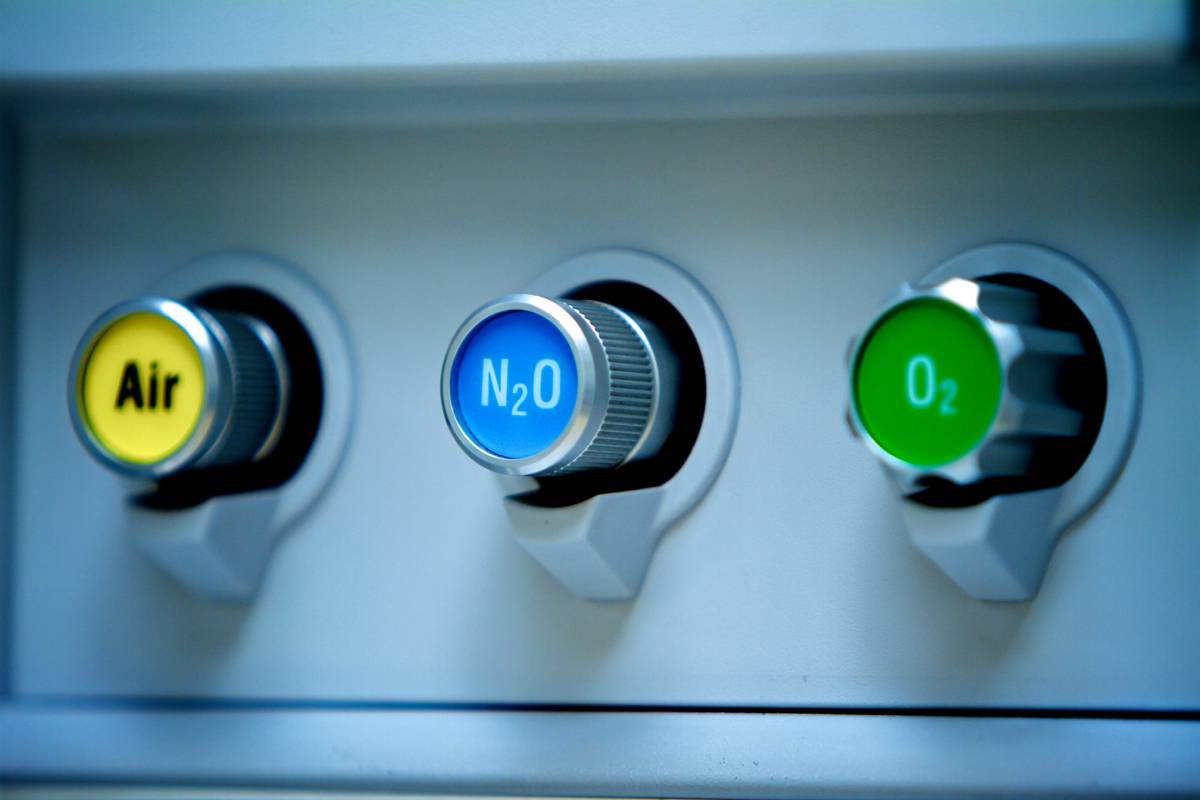Uses, Benefits, and Risks of Nitrous Oxide

Nitrous oxide (N2O) is a colorless gas with sedative and analgesic properties. It was first discovered in 1772 by English scientist Joseph Priestley, who heated ammonium nitrate in the presence of iron filings and then passed the gas that came off through water to remove toxic by-products 1. In 1844, the dentist Horace Wells attended a public demonstration of its use, after which he had one of his own teeth extracted under nitrous oxide. He was so impressed that he experimented on many patients prior to demonstrating his new findings at Harvard University, helping establish its clinical utility 2. Despite initially being used primarily for spectacle at traveling public shows, nitrous oxide was eventually firmly established as an anesthetic across clinical dentistry and medicine contexts. Because of its effects and benefits, nitrous oxide still has important clinical uses today.
Today nitrous oxide is used in many industries. Its main use tends to be as a mild sedative and analgesic. It helps to assuage the anxiety that many patients experience in relation to surgeries, dental treatment in particular, while offering a certain degree of pain relief. Because nitrous oxide is a gas, its effects depend on its concentration in the administered gas mixture. Clinical responses to different concentrations of nitrous oxide include analgesia (at approximately 20%), behavioral disinhibition (40%), amnesia (60%), and unconsciousness (80%).
To distinguish between the analgesic and anesthetic uses of nitrous oxide, low concentration analgesic nitrous oxide is also termed psychotropic analgesic nitrous oxide. Psychotropic analgesic nitrous oxide has been successfully used to reduce craving among individuals undergoing withdrawal from alcohol, cannabis, and nicotine, helping to prevent relapse 3.
In moderately high concentrations, nitrous oxide functions as an anesthetic. Because of its low potency however, it is not used as a sole general anesthetic and is often combined with more powerful anesthetics to ensure general anesthesia with analgesia, a rapid recovery, and limited complications.
Nitrous oxide has a number of benefits in its uses as an anesthetic. Not only is it cheap, but it is also widely available and well known. Overall, most anesthetists consider that it has a very good safety profile given its low potency 4. It also has a more rapid onset and recovery period than some other anesthetics 2. However, its relative merits have yet to be tested in a large trial of effectiveness across anesthetic contexts 2.
The past five years have seen a rise in the recreational use of nitrous oxide, in particular across the dance and festival scenes. In the United Kingdom today, for example, following cannabis, nitrous oxide is the second most popular recreational drug. Considering the generally modest use of nitrous oxide and its relative safety, however, legal measures against it at this time have not been deemed necessary 4.
Contraindications for the use of nitrous oxide include respiratory infections and chronic obstructive pulmonary diseases. Patients with respiratory infections could contaminate their tubing and the breathing apparatus, placing other patients at risk. In addition, nitrous oxide with oxygen should not be used in patients with chronic obstructive pulmonary diseases since these patients partly depend on a low blood oxygen concentration to breathe properly. Finally, pregnancy may be a contraindication, but nitrous oxide with oxygen may be appropriate during pregnancy.
Despite its well-established safety profile, nitrous oxide can result in a number of side effects. Common side effects include nausea, hypoxia, and claustrophobia. In addition, it can lead in rarer cases to megaloblastic anemia, immunosuppression, ischemia, hypoxia, and increased intracranial pressure 2. Consistent, long-term exposure can lead to infertility. There is always a risk, as well, of vitamin B12-deficiency related neurological and hematological effects associated with the heavy use of nitrous oxide, which recreational users should remain informed of. Finally, contact with liquid nitrous oxide can cause severe frostbite 5.
Additional research remains to be carried out in order to confirm, elaborate, and specify the uses, benefits, and risks of nitrous oxide across a variety of clinical settings.
References
1. Nitrous Oxide | AACC.org. Available at: https://www.aacc.org/science-and-research/toxin-library/nitrous-oxide. (Accessed: 14th April 2023)
2. Myles, P. S., Leslie, K., Silbert, B., Paech, M. J. & Peyton, P. Review A Review of the Risks and Benefits of Nitrous Oxide in Current Anaesthetic Practice. Anaesth. Intensive Care 32, 165–172 (2004). doi: 10.1177/0310057X0403200202.
3. Daynes, G. & Gillman, M. A. Psychotropic analgesic nitrous oxide prevents craving after withdrawal for alcohol, cannabis and tobacco. Int. J. Neurosci. (1994). doi:10.3109/00207459408985987
4. van Amsterdam, J., Nabben, T. & van den Brink, W. Recreational nitrous oxide use: Prevalence and risks. Regul. Toxicol. Pharmacol. 73, 790–796 (2015). doi: 10.1016/j.yrtph.2015.10.017.
5. Nitrous Oxide | NIOSH | CDC. Available at: https://www.cdc.gov/niosh/topics/nitrousoxide/default.html. (Accessed: 14th April 2023)
